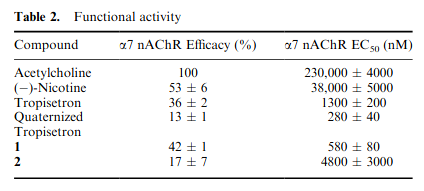Tropisetron
2022-03-04: Nootropics reference:
Tropisetron
 #
#
(-setron = 5-HT3 antagonist.)
- Inhibits IL-2 synthesis and transcription in stimulated T cells. Potent inhibitor of PMA+ionomycin-induced NF-κB activation, but TNF-α mediation is not affected.
- Very anxiolytic. Also a lowering of rumination is confirmed in studies for the treatment of OCD.
- Tropisetron protects against brain aging via attenuating oxidative stress, apoptosis and inflammation: The role of SIRT1 signaling (+SIRT1)
-
Tropisetron sensitizes α7 containing nicotinic receptors to low levels of acetylcholine in vitro and improves memory-related task performance in young and aged animals
- ~2.4 μM EC50 and 50 Imax for α7 nAChR partial agonism and 1.5 μM EC50 and 34 Imax @ α7β2 nAChR. And 20μM for α4 nAChR.
- Apparently has α3β4 nAChR blocking properties.
- 3 nΜ Ki for 5-HT3.
- [The 5-HT3 antagonist tropisetron (ICS 205-930) is a potent and selective alpha7 nicotinic receptor partial agonist]
-

- 55 Ki on α4β2 nAChR isn’t nothing, I suppose.
-
 so 36% efficacy for α7, where ACh has 100%. Nicotine has 53% actually, but good luck getting it to ever bind.
so 36% efficacy for α7, where ACh has 100%. Nicotine has 53% actually, but good luck getting it to ever bind. - 1.3 μM EC50 for α7.
-
-
Structural determinants for interaction of partial agonists with acetylcholine binding protein and neuronal α7 nicotinic acetylcholine receptor
- The carbonyl oxygen in the ester linkage between the indole and tropane moieties contributes to stabilize a network of four water molecules located in the apical portion of the interface.
- 5-HT–induced alteration in the autophagy proteins LC3-II and p62 was significantly blocked by the 5-HT3 receptor antagonist tropisetron,…
-
Tropisetron modulation of the glycine receptor: femtomolar potentiation and a molecular determinant of inhibition
- Iinhibitory effects occur at micromolar concentrations, whereas the potentiating effects are shown here to occur at femtomolar concentrations at the homomeric alpha1 (glycine) receptor. Potentiation implying it only occurred in the presence of glycine.
-
Adenylyl Cyclase (AC) Mediates the Antidepressant-Like Effects of Tropisetron on a Mouse Model of Maternal Separation Stress
- Administration of tropisetron at doses of 3 and 5 mg/kg (2x of 3) significantly increased the grooming activity time following the splash test. Forskolin showed similar results with 10 and 25 respectively. This is a nondepressive behavior.
-
Effect of tropisetron on circulating catecholamines and other putative biochemical markers in serum of patients with fibromyalgia
- U-shaped curve for dopaminergic properties, with >5mg being the turning point.. This is what causes constipation, I think.
- Also interesting how there’s a Calcitonin increase after prolnged use?
-
Tropisetron A Review of its Pharmacodynamic and Pharmacokinetic Properties, and Therapeutic Potential as an Antiemetic
- Minor 5-HT4 antagonism. This is what causes constipation, I think.
- This however showed partial agonism: 5HT4(a) and 5-HT4(b) receptors have nearly identical pharmacology and are both expressed in human atrium and ventricle
- Reduced the incidence of, or completely abolished, vomiting and retching induced by cytotoxic drugs such as cisplatin. Cytotoxic drugs cause gastrointestinal cellular damage which may result in the release of serotonin, activating vagal and possibly splanchnic afferent neurons which elicit the vomiting response. Tropisetron probably prevents emesis induced by cytotoxic agents by antagonising the effects of serotonin both at a peripheral (vagal) site and in the central nervous system at the terminus for vagal afferent fibres.
- Increased plasma and urine 5-HIAA in emetic patients.
- 52% for 20mg dose and 66% for 100mg dose Fischer et al 1992)
- Minor 5-HT4 antagonism. This is what causes constipation, I think.
-
Serotonin receptor type 3 antagonists improve obesity-associated fatty liver disease in mice.
- (.06 mg/kg HED) Tropisetron treatment significantly reduced liver fat content (-29%), liver inflammation (-56%), and liver cell necrosis (-59%) in ob/ob mice.
- Four-week-old ob/ob mice and lean controls were treated for 6 weeks orally with tropisetron or palonosetron at 0.2 mg/kg per day.
- Reduced liver fat content (-29%), liver inflammation (-56%), and liver cell necrosis (-59%). Decreased plasma Alanine Aminotransferase, and portal vein Endotoxin levels. Caused a reduction of elevated serotonin levels and an increase of SERT in the duodenum.
-
The 5-HT3 receptor antagonist ondansetron potentiates the effects of the acetylcholinesterase inhibitor donepezil on neuronal network oscillations in the rat dorsal hippocampus
- Prolonged the theta and gamma currents
-
The acute effect of tropisetron on ECG parameters in cancer patients
- Did not result in QT interval, etc. @ 5mg IV.
-
https://www.medsafe.govt.nz/profs/Datasheet/t/tropisetronaftinj.pdf
- At very high repeated doses, visual hallucinations and, in patients with pre-existing hypertension, an increase in blood pressure, have been observed.
- At the 5 mg dose, constipation and, less frequently, dizziness, fatigue, somnolence, and gastrointestinal disorders, such as abdominal pain, diarrhoea and anorexia were observed as well.
Neuroprotection #
-
Tropisetron and its targets in Alzheimer’s disease (Hashimoto 2015)
- Promoted greater improvements in memory than current AD therapeutic drugs, such as memantine and Donepezil.
- The multi-functional drug tropisetron binds APP and normalizes cognition in a murine Alzheimer’s model
-
Tropisetron as a neuroprotective agent against glutamate-induced excitotoxicity and mechanisms of action
- Neuroprotection against glutamate-induced excitotoxicity is mediated by α7 nAChR activation.
- caused internalization of NR1A
- Decreases p38 levels.
- Several studies have suggested that Ca influx through activated nAChRs affects phosphorylation level of the p38 MAPK and Akt intracellular signaling pathways resulting in neuroprotection
-
The effect of tropisetron on oxidative stress, SIRT1, FOXO3a, and claudin-1 in the renal tissue of STZ-induced diabetic rats
- Reversed decrease in SIRT1 and increase in NF-κB, p-FOXO3 and claudin-1.
-
The multi-functional drug tropisetron binds APP and normalizes cognition in a murine Alzheimer’s model
- Incresed sAPPα/Aβ ratio; it binds directly to APP.
- Soluble amyloid precursor protein, which is actually a trophic factor. Inhibits caspase activation, cell eath, and neurite retraction.
- Aβ monomers eventually aggregate into soluble oligomers and insoluble plaques.
- Incresed sAPPα/Aβ ratio; it binds directly to APP.
- Reduces IL-1, IL-6, TNF-α, NF-κB and I’m sure other things in rat models of colitis. R
-
Tropisetron upregulates cannabinoid CB1 receptors in cerebellar granule cells: Possible involvement of calcineurin
- It significantly inhibits calcineurin, which regulates the CB1 expression. Calcineurin is highly expressed in Granule Cells, and they do not express 5-HT3. Indeed, other calcineurin inhibitors like FK506/tacrolimus also increase CB1 expression.
Supplementation #
- 3 year shelf life. 6-8 hour half-life.
- 1-2 mg daily should be safe. 5-10 most effective. 66-80% bioavailability. Renal/fecal excretion. Highly brain permeable.
- Bromantane.co: $33 - 15 mL x 20 mg= 300 mg or 5mg per 0.25mL.
- It’s in HCl now with potarssium sorbate (shown to cause nasal inflammation) Brendan has made a nasal spay and says 1 spray (2mg) is similar to 5mg oral.